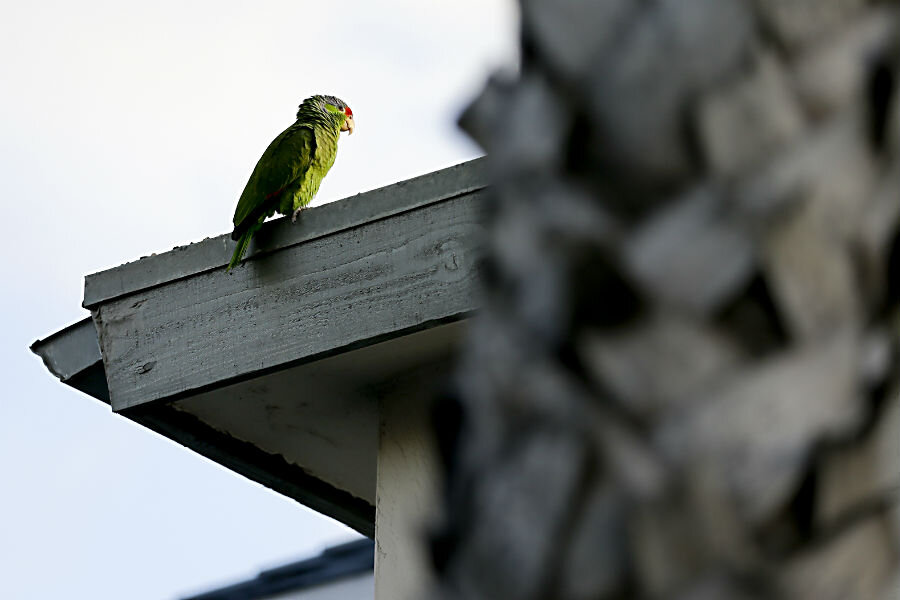Red-crowned parrots find sanctuary in US cities as Mexican cousins struggle
Loading...
| San Diego
US researchers are launching studies on Mexico's red-crowned parrot — a species that has been adapting so well to living in cities in California and Texas after escaping from the pet trade that the population may now rival that in its native country.
The research comes amid debate over whether some of the birds flew across the border into Texas and should be listed under the Endangered Species Act.
Parrots in U.S. urban areas are just starting to draw attention from scientists because of their intelligence, resourcefulness and ability to adapt. There is also a growing realization that the city dwellers may offer a population that could help save certain species from extinction.
Parrots are thriving today in cities from Los Angeles to Brownsville, Texas, while in the tropics and subtropics, a third of all parrot species are at risk of going extinct because of habitat loss and the pet trade.
Most are believed to have escaped from importers or smugglers over the past half-century, when tens of thousands of parrots were brought into the United States from Latin America.
Scientists only now are starting to study them.
After doing most of his research in places like Peru, Donald Brightsmith is concentrating on the squawking birds nesting in Washingtonian palms lining avenues and roosting in the oak trees in front lawns in South Texas.
"Parrots in urban settings are of great interest to me," the Texas A&M University biologist said. "I see these as kind of future insurance policies."
Brightsmith has received a two-year grant from the Texas Parks and Wildlife Department to get an official count on the state's red-crowned parrot population and determine whether threats against them are increasing.
The loud, ruckus birds have been shot at by angry homeowners and their young poached from nests.
In San Diego, a $5,000 reward is being offered for information on the killings of about a half-dozen parrots found shot this year.
The research could help drive ways to maintain the population that prefers the cities and suburbs.
"It's more of an urban planning, landscape, ecology issue and not so much how do we protect an area of pristine nature," he said. Brightsmith would like to team up with scientists in California.
Researchers want to someday study the gene pool to determine whether there are still genetically pure red-crowned parrots that could replenish the flocks in their native habitat.
"We could have a free backup stock in the US," Brightsmith said.
In Mexico, biologists are working on getting an updated count. The last study in 1994 estimated the population at 3,000 to 6,500 birds, declining from more than 100,000 in the 1950s because of deforestation and raids on the nesting young to feed the pet trade.
"We suspect the population in South Texas could rival the number found in the wild in Mexico," said Karl Berg, a biologist at the University of Texas Rio Grande Valley who received a grant to study the red-crowned parrot in Brownsville.
Biologists estimate the population at close to 1,000 birds in Texas and more than 2,500 in California, where they are the most common of more than a dozen parrot species.
The Texas Parks and Wildlife Department in 2011 listed it as an indigenous species because it is thought the parrots flew north across the border as lowland areas in Mexico were cleared in the 1980s for ranching and agriculture, though ornithologists debate that.
The U.S. Fish and Wildlife Service that same year announced that the red-crowned parrot warranted federal protection because of habitat loss and poaching for the pet trade. It remains a candidate, and the agency reviews it annually.
Some in the pet trade fear that a listing under the Endangered Species Act could prevent them from breeding the birds and moving them across state lines.
Conservationists question whether any of the birds are native to Texas and should be listed when there are so many species in need of protection in the United States.
"It seems odd to me," said Kimball Garrett, a parrot expert at the Natural History Museum of Los Angeles County. "I don't know that there is enough evidence to show the birds flew for hundreds of miles from their native range and went across the border."
Brooke Durham said the birds need more protection. Durham runs a parrot rescue center called SoCal Parrot in the town of Jamul, east of San Diego, and treats up to 100 birds a year.
Recently at her sprawling home-turned-sanctuary, dozens of birds were being nursed for broken bones and pellet gun wounds. Most were red-crowned parrots.
Animal cruelty laws offer about the only protection for the birds in California, because they are not native to the state or migratory.
"People complain about the noise, but they're just not educated about the birds," she said. "They don't realize these birds are endangered."







